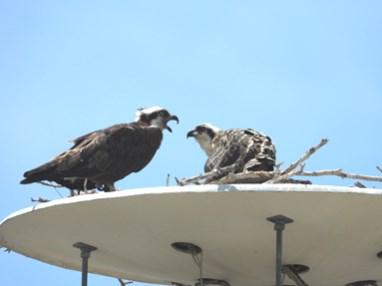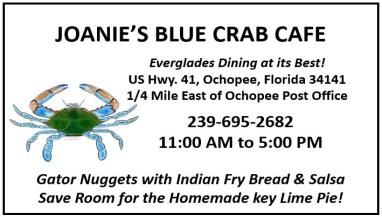The MULLET RAPPER First Annual Everglades City Chili Cookoff A Huge Success! The very first annual Everglades City Chili Cookoff was a tremendous success. Spearheaded by Hazel Mitchell and the Chokoloskee Church of God Ladies Ministry, the event attracted over 100 guests and included 14 entries! The community was obviously ready to compete and eat. For a $5 donation, eventgoers could sample chili from each entry. By day’s end, a vote was taken and the winners announced. Aaron (Right) & David( Center) Tabor of Parkway Motel & Villas took home the first place trophy and a $100.
Havana Café and Carlos Valdez (below, left) brought home the second place medal for their delicious entry.
Island Café (below) was awarded the 3rd place medal for their flavor-packed entry.
All in all, it was a very successful day for the new event and a nice day out for the local community. We congratulate the Chokoloskee Church of God’s Ladies Ministry for a very successful event. We look forward to the 2nd Annual Chili Cookoff event in 2022. Photo credit: Top, Hazel Mitchell email: mulletrapper@gmail.com
What’s Happening in the Everglades & 10,000 Islands At 6-Weeks Old, Young Osprey Demand Food Throughout the Day By Kathy Brock
With an osprey tower located directly in front of our property, we have been able to watch the entire nesting season cycle for the native Osprey up close each day. Nest building, which began in earnest in December, seems to be an ongoing process. Throughout the cycle, the adults continue to reinforce their nest bringing twigs, grasses and even some crab trap rope as a reinforcement. We think the chicks hatched February 8. Chicks typically stay in the nest for 60 days, so that would mean they should be ready to fly by April 6th. Several times a day the babies will exercise their wings preparing for the first flight, so they seem to be on target for early April. The adults share the workload. The female spends the most time at the nest, but the male comes to the nest to relieve her on a regular basis. Routinely, the male will bring a fish to his roost to eat on it for a bit before he takes it to the nest for the rest of the family. As he eats, his mate cries out continually to let him know that the two chicks are hungry. We have seen several species of fish on the menu, tilapia, ladyfish, mangrove snapper and small snook. Photo Above: The female osprey (left) communicating to one of her two chicks on March 29th.
Open 8:oo am to 3:00 pm Daily
PAGE 9
April 3, 2021 Lights Out, Stash the Trash. It’s Sea Turtle Nesting Season!
The Florida Fish and Wildlife Conservation Commission (FWC) is reminding beachgoers they can help protect nesting sea turtles by practicing some simple tips. Each year, thousands of sea turtles nest on Florida’s beaches. Because our state is so important to these special animals, beachgoers can help keep our beaches clean and dark so sea turtles nest successfully. Everyone benefits from clean beaches and, since most of Florida’s sea turtles nest at night, it is important to keep our beaches dark because bright lights can disorient nesting turtles. Stash the trash! Obstacles on the beach can prevent sea turtles from nesting as they crawl from the water, across the sand, to lay their eggs. They can also prevent sea turtle hatchlings from reaching the water once they emerge from their nests. Beachgoers can help sea turtles by properly disposing of all trash, filling in holes in the sand, and putting away boats, beach toys and furniture. Fishing line can be deadly to sea turtles and other wildlife, so be sure to dispose of it properly. To find a monofilament recycling station near you, visit mrrp.myfwc.com. Lights out! Bright lighting can misdirect and disturb nesting sea turtles and their hatchlings, leading them away from the ocean and toward potential danger, so beachgoers should avoid using flashlights or cellphones on the beach at night. Anyone living along or visiting Florida beaches can do their part by turning out lights or closing curtains after dark to ensure nesting turtles are not disturbed as they come ashore and hatchlings will not become disoriented when they emerge from their nests. If lighting could still be visible from the beach, be sure it is long, low and shielded. “As beachgoers, we can all do our part to help sea turtles survive,” said Dr. Robbin Trindell, who heads the FWC’s sea turtle management program. “By keeping beaches dark and clearing the way at the end of the day, we can help ensure that these amazing animals keep returning to our beautiful state.” Other ways to help sea turtles include reporting those that are sick, injured, entangled or dead to the FWC’s Wildlife Alert Hotline at 888-404-FWCC (3922). Purchasing a “Helping Sea Turtles Survive” Florida license plate contributes to sea turtle research, rescue and conservation efforts. People also can donate $5 and receive an FWC sea turtle decal. For more information please, visit MyFWC.com/Sea Turtle. www.visitevergladescity.com





